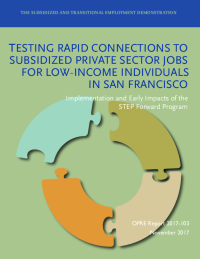Testing Rapid Connections to Subsidized Private Sector Jobs for Low-Income Individuals in San Francisco
Implementation and Early Impacts of the STEP Forward Program

Securing unsubsidized employment in a competitive labor market can be difficult for low-income job seekers in an economy that is increasingly driven by highly skilled technical and professional employment. This is particularly the case in San Francisco, whose tech boom has received national attention for dramatically, but unevenly, affecting the city’s economic landscape. San Francisco has a scarcity of opportunities for individuals who are less educated or lack the higher skills required by the jobs that have driven the economy’s growth. More than ever, securing stable employment is a must for lower-income workers in both San Francisco and the United States at large. While subsidized jobs can be designed to teach participants basic work skills, give them work experience that can be used on future résumés, or help them get a foot in the door with employers, past research has found mixed results regarding these programs’ ability to affect participants’ employment rates or earnings in the long term.
The STEP Forward program attempted to address these issues by offering job seekers opportunities to interview for jobs with private sector employers at weekly job fairs, and by offering employers temporary wage subsidies to encourage them to try out job seekers whom they might not otherwise hire, with the goal of ultimately hiring these workers into permanent unsubsidized employment. A diverse group of low-income job seekers enrolled in the program, the vast majority of whom were either CalWORKs (California’s Temporary Assistance for Needy Families program) clients, individuals who had exhausted their unemployment insurance benefits, or CalFresh (California’s Supplemental Nutrition Assistance Program) recipients.
This report presents implementation findings and interim impact results (with a one-year follow-up) from a random assignment evaluation of STEP Forward. Findings from the report include the following:
-
The program greatly increased receipt of employment services, which was unsurprising given that most of the program group received job-readiness services through STEP Forward, while control group members could receive such services only through other programs and services they found in the community. While over half of the control group reported receiving help with finding or keeping a job, likely through other programs and services they found in the community, nearly 94 percent of the program group received these services. These services included help with job searches, job referrals, developing a résumé, filling out job applications, and preparing for job interviews, among other activities. STEP Forward offered many of these services to program group members in the form of job-readiness activities.
-
A little over a third of program group members never interviewed for a subsidized job, and among those who interviewed and were hired (25 percent), it took about three and a half months on average from the date of random assignment to the first day worked. While a high percentage (82 percent) of program group members received job-readiness services, a significant number of participants (36 percent) never had an interview with employers, the key service offered by STEP Forward. The number of participants who were placed in a subsidized job and the length of time it took were influenced by a variety of factors, such as the competitive nature of interviewing for and getting a subsidized job, the types of jobs available, and the skills and interests of the participants.
- In the first year after random assignment, program group members were more likely than control group members to have been employed, had higher average earnings, and may have been employed in higher-quality jobs. These impacts appear to have been driven by the subsidized employment itself during this period and diminished as subsidies ended. Nearly 70 percent of the control group worked in the year following random assignment according to administrative records. However, three-quarters of program group members were employed in the year following random assignment, resulting in an impact on employment of 5.6 percentage points. Program group members also worked in slightly more quarters and earned approximately $1,600 more (including the subsidy amount) than control group members, on average, in the year following random assignment. Impacts on employment and earnings rose and fell in line with participation in subsidized jobs. As subsidies ended, differences in the employment rates and earnings of the program and control groups narrowed.






